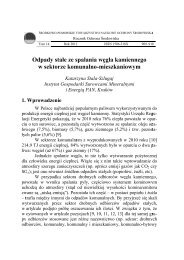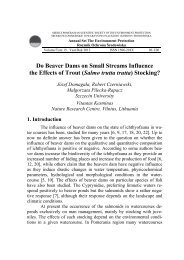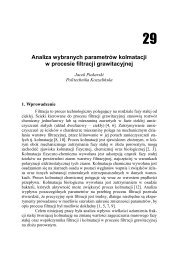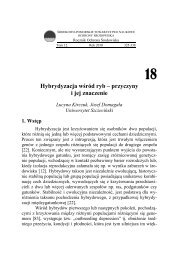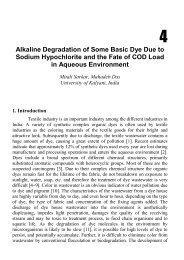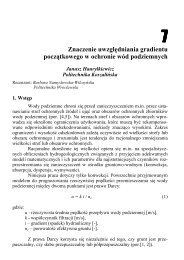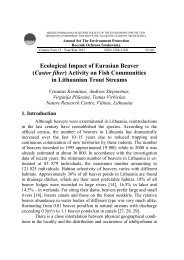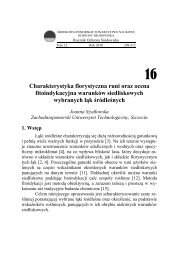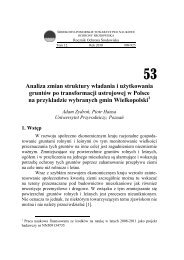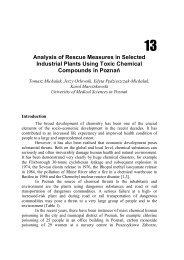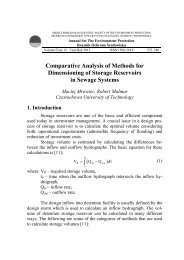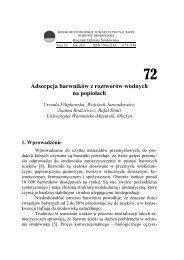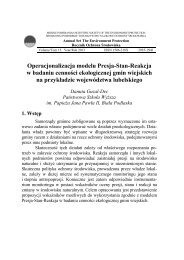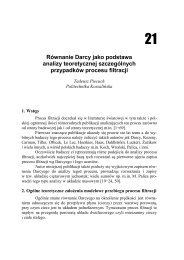High-pressure Water Jet Technology Application for Abyssal Well ...
High-pressure Water Jet Technology Application for Abyssal Well ...
High-pressure Water Jet Technology Application for Abyssal Well ...
Create successful ePaper yourself
Turn your PDF publications into a flip-book with our unique Google optimized e-Paper software.
<strong>High</strong>-<strong>pressure</strong> <strong>Water</strong> <strong>Jet</strong> <strong>Technology</strong><br />
<strong>Application</strong> <strong>for</strong> <strong>Abyssal</strong> <strong>Well</strong> Renovation<br />
1. Introduction<br />
Przemysław Borkowski<br />
Unconventional Hydro<strong>Jet</strong>ting <strong>Technology</strong> Center<br />
Koszalin University of <strong>Technology</strong><br />
2<br />
In order to ensure long lasting and efficient delivery of water characterized<br />
with good quality, it is necessary to own high efficiency technical equipment<br />
but first of all abyssal well enabling to draw the water up. However usual<br />
exploitation of such wells leads to constant growing old, what depends on many<br />
constructional parameters, technical equipment as well as on hydraulic and hydro-chemical<br />
properties of near orogenic belt and underground water [7].<br />
Taking above purposes into consideration, in order to choose adequate<br />
renovation strategy and conservation, the fact of well ageing process is unavoidable.<br />
This process causes parallel well efficiency decrease that in consequence<br />
might effects in well devastation and irreversible changes to the water<br />
intake [11]. There<strong>for</strong>e, the main reason of all renovation processes is to restore<br />
well efficiency and stop aging processes.<br />
One of the most efficient renovation method of deep well is to introduce<br />
high-<strong>pressure</strong> water jet technique [2, 3]. Adequate water jets are selected each<br />
time <strong>for</strong> practical incrustation conditions of the filters and water-bearing layers<br />
silting-up. This paper presents own experiences in effective renovation of deep<br />
well filters utilizing high-<strong>pressure</strong> water jet.<br />
2. <strong>Abyssal</strong> well exploitation<br />
Typical exploitation of well cause constant construction ageing that depends<br />
on many parameters mentioned above as well as on the following ones<br />
influencing efficiency decrease:
Przemysław Borkowski<br />
� corrosion of construction and pumping equipment,<br />
� water-bearing layers silting-up as well as filtering gravel caused by fine<br />
grains fractions,<br />
� incrustations occurring as an effects of hydro-chemical and microbiological<br />
processes,<br />
� pumping equipment failure,<br />
� effectiveness decrease of water-bearing <strong>for</strong>mations caused of excessive exploitation<br />
or changing of reproduction mechanisms.<br />
In this way it occurs that after several years its efficiency is decreased<br />
(Fig. 1). This situation is often connected with worse water quality. Such situation<br />
after few dozen years results in creation of hard nodular sediments that are<br />
deposit inside. Efficient renovation of such accretions is an essential problem<br />
because these impurities are characterized with great adhesion and their main<br />
components are compounds of iron, manganese, calcium and silicon.<br />
Fig. 1. Efficiency characteristics of typical working well (without renovation)<br />
Rys. 1. Charakterystyka wydajnościowa pracy typowej studni (bez renowacji)<br />
<strong>Well</strong> water pumping efficiency depends on filter inlet surface AF as<br />
well as on its critical flow through the filter. It can be described by the following<br />
<strong>for</strong>mula:<br />
where:<br />
DF – outer diameter of the filter [m],<br />
Q = � · DF · HF · VC [m 3 /s] (1)<br />
40 Środkowo-Pomorskie Towarzystwo Naukowe Ochrony Środowiska
<strong>High</strong>-<strong>pressure</strong> <strong>Water</strong> <strong>Jet</strong> <strong>Technology</strong> <strong>Application</strong> <strong>for</strong> <strong>Abyssal</strong> <strong>Well</strong> Renovation<br />
HF – hydraulic height of the filter [m],<br />
Vc – critical flow velocity close to outer wall of the filter [m/s].<br />
Converting the above expression, it is possible to establish critical water<br />
flow:<br />
V<br />
c<br />
�<br />
� �<br />
Q<br />
D � H<br />
Tom 11. Rok 2009 41<br />
F<br />
F<br />
[m/s] (2)<br />
The value of above determined flow depends on maximum pumping<br />
efficiency which decreases together with exploitation time.<br />
Generally, critical inlet water velocity <strong>for</strong> filter gaps should not exceed<br />
the value of 0.03 m/s. In turns, critical outlet ground water velocity flowing out<br />
to filter gravel ridge should achieve the values range 0.02 to 0.03 m/s [8].<br />
3. <strong>Abyssal</strong> well renovation<br />
After few decades of exploitation water-bearing and filtering gravel is<br />
naturally silting-up. It makes water flow difficulties by its inflow decrease into<br />
the well that causes in turns its efficiency problems.<br />
Until recently, this kind sediment was removed by chemical or mechanical<br />
methods using different types of scrappers [7, 8]. However those<br />
standard renovation techniques don’t assure enough high level of their renovation<br />
as it is presented in Fig. 2.<br />
relative efficientcy [%]<br />
100<br />
80<br />
60<br />
40<br />
20<br />
0<br />
0<br />
1. regeneration<br />
2. regeneration<br />
5 10 15 20<br />
3. regeneration<br />
years<br />
Fig. 2. Typical time course of well relative efficiency including regeneration<br />
Rys. 2. Typowy przebieg czasowy wydajności względnej studni uwzględniający regenerację
Przemysław Borkowski<br />
Effects that are much more efficient can be assured by introducing water<br />
jet technology [1, 4]. Firs time it was used over 25 years ago in the USA to<br />
deep well filters cleaning [13, 17]. Thanks to achieved high efficiency of this<br />
method, it was adopted <strong>for</strong> different applications [6, 10, 12, 16] and there<strong>for</strong>e<br />
introduced in many countries [5, 8, 9, 10, 16]. Nowadays, similar hydro-jet<br />
techniques have also been used <strong>for</strong> the cleaning of well systems [1, 8, 9, 12].<br />
Considering above, such method needs some more characteristic that is<br />
presented in this paper.<br />
4. Problem diagnosis<br />
In order to estimate the amount of well devastation and necessary renovation<br />
conditions special TV cameras are used <strong>for</strong>. One of the newest types of<br />
such systems is exemplified on Fig. 3. Specific character of well installation<br />
causes that camera used <strong>for</strong> inspection should ensure higher working <strong>pressure</strong><br />
standards because well depth can reach even to 300 m.<br />
a) b)<br />
Fig. 3. TV Supervision iPEK TV-camera used <strong>for</strong> deep well monitoring (a) equipped<br />
with semi-automatic cable winder drum (b)<br />
Rys. 3. Kamera telewizyjna firmy Supervision iPEK do monitorowania studni<br />
głębinowych (a) wyposażona w półautomatyczny bęben do nawijania<br />
przewodów sygnałowych (b)<br />
42 Środkowo-Pomorskie Towarzystwo Naukowe Ochrony Środowiska
<strong>High</strong>-<strong>pressure</strong> <strong>Water</strong> <strong>Jet</strong> <strong>Technology</strong> <strong>Application</strong> <strong>for</strong> <strong>Abyssal</strong> <strong>Well</strong> Renovation<br />
Such a specialist TV monitoring should include following characteristic<br />
technical details:<br />
� all well pipes including their corrosion stage,<br />
� all pipes connections,<br />
� individual elements of the filtering pipe especially filtering dilatations.<br />
Proper monitoring let to prepare conscious regeneration in the next step.<br />
Thanks to that, sometimes it is possible to ‘find’ old lost parts of hydro technical<br />
installation. Special evident <strong>for</strong> that could be extraction of three-segmented<br />
slotted filter pipe [4] of 18 m length (Fig. 4), which was lost during improper<br />
regeneration.<br />
Fig. 4. Slotted stainless steel filter extracted from well bottom after 75 years of its<br />
exploitation<br />
Rys. 4. Szczelinowy filtr wykonany ze stali nierdzewnej wyciągnięty z dna studni po 75<br />
latach jej eksploatacji<br />
5. Conditions of wells’ hydro-jetting cleaning<br />
A special designed rotary heads are used <strong>for</strong> high-<strong>pressure</strong> water jet<br />
wells cleaning (Fig. 5) that are equipped in adequate type and number of water<br />
nozzles [15]. Technological water is <strong>pressure</strong>d to necessary level [14] in the<br />
hydro-pump system.<br />
<strong>High</strong>-<strong>pressure</strong> water of adequate parameters is directed next to the<br />
working head through special hoses. This process is connected with <strong>pressure</strong><br />
lost that depends on nominal water <strong>pressure</strong> and its output as well as on working<br />
head type and used hose dimensions. Fig. 6 illustrates some exemplary relations<br />
of mentioned <strong>pressure</strong> loss.<br />
Tom 11. Rok 2009 43
Przemysław Borkowski<br />
Fig. 5. Different rotary working heads types used <strong>for</strong> high-<strong>pressure</strong> water jet wells<br />
cleaning<br />
Rys. 5. Różne typy głowic obrotowych używanych do wysokociśnieniowego<br />
czyszczenia studni głębinowych<br />
p/pn [%]<br />
100<br />
90<br />
80<br />
70<br />
6 orifices 1,0mm<br />
6 orifices 1,2mm<br />
6 orifices 1,5mm<br />
0 25 50 75 100 125<br />
L [m]<br />
150 175 200 225 250<br />
Fig. 6. Influence of hose length and water orifice diameter of six-orifice cleaning head<br />
on the working <strong>pressure</strong> <strong>for</strong> hose diameter of 12.5 mm, (pn=25 MPa)<br />
Rys. 6. Wpływ długości węża wysokociśnieniowego i średnicy otworu<br />
sześciootworowej głowicy czyszczącej na ciśnienie robocze strugi dla średnicy<br />
węża 12,5 mm, (pn=25 MPa)<br />
44 Środkowo-Pomorskie Towarzystwo Naukowe Ochrony Środowiska
<strong>High</strong>-<strong>pressure</strong> <strong>Water</strong> <strong>Jet</strong> <strong>Technology</strong> <strong>Application</strong> <strong>for</strong> <strong>Abyssal</strong> <strong>Well</strong> Renovation<br />
Such a renovation conditions are mainly connected with the filter type<br />
and its technical condition [4], water-bearing layers type and material parameters<br />
of the well e.g. pipe material type resistance on corrosion intensity as well<br />
as on abyssal wells diameter and depth [1].<br />
6. Regeneration technology outline<br />
The matter of hydrodynamic regeneration of deep wells consists in<br />
proper <strong>for</strong>mulated high-<strong>pressure</strong> water jet [1, 2, 3] that is introduced inside the<br />
well pipe especially in the filtering zone. Such high-<strong>pressure</strong> cavitating water jet<br />
created inside special multi-outlet working heads reacts directly on sediments.<br />
Heterogeneity of such water jet also its adequate geometrical displacement in<br />
rotating head causes that the influence area is in practice a few dozen times<br />
larger than <strong>for</strong> standard high-<strong>pressure</strong> jet. In consequence such process of sediments<br />
erosion causes much efficient washing out of silting-up layers.<br />
In practice, rotating working heads characterized with spatial nozzles<br />
orientation are used <strong>for</strong> such regeneration processes (Fig. 7). Adequate synchronization<br />
of rotary movements of such self-driven head with its reciprocating<br />
vertical movements (along the filter pipe) ensures efficient cleaning of the filter<br />
as well as nearby gravel zone. The same way, but not such intensively, the upper-<br />
and under-filter pipe is cleaned.<br />
Fig. 7. Schematic view of well renovation process using HydroBor system:<br />
1 – hydromonitor, 2 – hose, 3 – working nozzle, 4 – well filter, 5 – water-bearing<br />
layer, 6 – pollution draining<br />
Rys. 7. Schemat procesu renowacji studni przy użyciu systemu HydroBor:<br />
1 – hydromonitor, 2 – wąż, 3 – głowica robocza, 4 – filtr, 5 – złoże wodonośne,<br />
6 – odsysanie zanieczyszczeń<br />
Tom 11. Rok 2009 45
Przemysław Borkowski<br />
Thanks to mentioned cavitations effect and pulsing water pumping after<br />
regeneration, impurities separated from the filter surface are then sucked out of<br />
the well.<br />
7. Process efficiency<br />
Above described regeneration process efficiency is very high. Such method<br />
ensures values of water critical flow through the filter exceeding 0,0025<br />
m/s and the same way suitable level of effectiveness enlargement. If regeneration<br />
process doesn’t need additional cleaning of external water-bearing layers,<br />
total operational time of the well renovation usually includes between 12 to 18<br />
hours.<br />
Thanks to TV inspection that enables proper recognition of technical<br />
conditions of pipe and filter, it is possible to establish adequate method and<br />
requirements <strong>for</strong> its renovation as well as technology effectiveness after<br />
processing. Exemplary photographs in Fig. 8 present situation be<strong>for</strong>e and right<br />
after (Fig. 9) proper renovation was introduced. Such technology, taking into<br />
account a marginal financial cost of its realization ensures good efficiency of<br />
the well operation that is close to its after built state.<br />
a) b)<br />
Fig. 8. Exemplary view of well inside showing out filter zone be<strong>for</strong>e renovation:<br />
a – general view, b – technological water inlet hole incrustation<br />
Rys. 8. Przykładowy widok wnętrza studni ukazujący strefę filtra przed renowacją:<br />
a – widok ogólny, b – inkrustacja napływowego otworu technologicznego<br />
46 Środkowo-Pomorskie Towarzystwo Naukowe Ochrony Środowiska
<strong>High</strong>-<strong>pressure</strong> <strong>Water</strong> <strong>Jet</strong> <strong>Technology</strong> <strong>Application</strong> <strong>for</strong> <strong>Abyssal</strong> <strong>Well</strong> Renovation<br />
A<br />
Fig. 9. Exemplary view of well inside showing out filter zone after regeneration:<br />
A – general view, B – cleaned technological water inlet holes<br />
Rys. 9. Przykładowy widok wnętrza studni ukazujący strefę filtra po renowacji:<br />
A – widok ogólny, B – wyczyszczone otwory technologiczne<br />
8. Conclusion<br />
It should be stated in the conclusion that presented above technology introduces<br />
new quality in hydro-technical equipment regeneration, especially <strong>for</strong><br />
deep wells. These are economically advantageous methods, well-founded considering<br />
civilization and urban situations. But they need rational acting basing<br />
on natural and environmentally friendly methods introduction like hydrojetting<br />
technologies assisted with monitoring inspection.<br />
References<br />
1. Borkowska K., Borkowski P.: <strong>High</strong>-<strong>pressure</strong> water jet applications in hard to<br />
reach hydro-technical installations renovation. Sci. Book Univ. Technol. Koszalin,<br />
No. 36, 465-474, 2004.<br />
2. Borkowski J., Borkowski P.: <strong>High</strong>-<strong>pressure</strong> water jet usage to abyssal well renovation.<br />
Journal of Machine Engineering. Vol. 7, No.4, 47-53, 2007.<br />
3. Borkowski P.: <strong>Application</strong> of high-<strong>pressure</strong> water jet <strong>for</strong> abyssal well renovation.<br />
19 th Int. Conf. on <strong>Water</strong> <strong>Jet</strong>ting. Nottingham, UK, 79-86, 2008.<br />
4. Borkowski J., Borkowski P. et all: <strong>Water</strong> intake renovation according to experimental<br />
technology introduced <strong>for</strong> WOP – Uniescie. New technology application,<br />
Koszalin, 1994.<br />
5. Borkowski P.: Novel technology of water pipeline cleaning using high <strong>pressure</strong><br />
water jet. 7 th Pacific Rim Int. Conf. on <strong>Water</strong> <strong>Jet</strong>ting <strong>Technology</strong>. Jeju, Korea,<br />
315-320, 2003.<br />
6. Borkowski J., Borkowski P.:: <strong>Application</strong> of high-<strong>pressure</strong> water jets to inaccessible<br />
pipeline cleaning. Int. Simp. on Unconventional Hydro<strong>Jet</strong>ting Technologies.<br />
Koszalin, 193-202, 2007.<br />
Tom 11. Rok 2009 47<br />
B
Przemysław Borkowski<br />
7. Detay M.: <strong>Water</strong> wells – Implementation, Maintenance and Restoration. Wiley<br />
and Sons Publ. Chichester, 1997.<br />
8. Houben G., Treskatis C.: Regenerirrung und Sanierung von Brunnen. Oldenbourg<br />
Industrieverlag GmbH. München, 2003.<br />
9. Johnson A., Eslinger D.: A new abrasive jetting system <strong>for</strong> oil-well scale removal.<br />
15 th Int. Conf. on <strong>Jet</strong>ting <strong>Technology</strong>. Ronneby, 403-418, 2000.<br />
10. Kuroda M., Kang W.: Pipe polymer removing by using an ultra high-<strong>pressure</strong><br />
water jet. 7 th Pacific Rim Int. Conf. on <strong>Water</strong> <strong>Jet</strong>ting <strong>Technology</strong>. Jeju, Korea,<br />
341-346, 2003.<br />
11. Mansuy N.: <strong>Water</strong> well rehabilitation. CRC Press, Boca Raton, 1998.<br />
12. Wang R., Shen Z., Yang Y.: <strong>Water</strong> jet technology in petroleum engineering. 8 th Pacific<br />
Rim Int. Conf. on <strong>Water</strong> <strong>Jet</strong> <strong>Technology</strong>. Quingdao. Paper No. 4, 43-56, 2006.<br />
13. Wolgamott J.E., Zink G.P.: Optimizing jet cutting power <strong>for</strong> tube cleaning. 2 nd U.S.<br />
<strong>Water</strong> <strong>Jet</strong> Conference. Rolla, Missouri, 143-150, 1983.<br />
14. Wright D., Wolgamott J., Zink G.: Safe waterjet cleaning of sewer pipe. 2005 WJTA<br />
American <strong>Water</strong>jet Conference. Houston, Texas, Paper No. 2B-2, 2005.<br />
15. Wright D., Wolgamott J., Zink G.: A comparison of tube nozzle per<strong>for</strong>mance. 2007<br />
American WJTA Conference and Expo. Houston, Texas, Paper No. 3-A, 2007.<br />
16. Zhang L., Jiao Y., Zhang Q.: Cleaning the oil-gas lines on catalytic cracker until<br />
in oil refinery using high-<strong>pressure</strong> water jet technique. 10 th Am. <strong>Water</strong>jet Conference.<br />
Houston, Texas, 585-593, 1999.<br />
17. Zublin C.W.: <strong>Water</strong> jet cleaning speeds – theoretical determinations. 2 nd U.S.<br />
<strong>Water</strong> <strong>Jet</strong> Conference. Rolla, Missouri, 159-166, 1983.<br />
Streszczenie<br />
Zastosowanie wysokociśnieniowej strugi wody do<br />
czyszczenia studni głębinowych<br />
W artykule zaprezentowano efektywną metodę hydrostrumieniowego czyszczenia<br />
zakolmatowanych rur i filtrów studni głębinowych po kilkudziesięciu latach ich<br />
eksploatacji. Metoda ta polega na wprowadzeniu do wnętrza regenerowanej studni specjalnie<br />
skonstruowanej wysokociśnieniowej głowicy roboczej, z której wypływa wysokociśnieniowa<br />
struga wody charakteryzująca się turbulentną wielofazową strukturą.<br />
Struga ta zapewnia wystarczająco wysoką energię, aby skutecznie rozbić zalegające<br />
wewnątrz osady a jednocześnie nie spowodować zniszczenia delikatnej konstrukcji<br />
filtrującej. Wytrącone w ten sposób osady, odsysane są następnie wraz z poprocesową<br />
wodą na zewnątrz rurociągu a całość operacji regeneracyjnej kończy etap płukania.<br />
Metoda ta zapewnia wysoką, przeszło 90% skuteczność odtwarzania pierwotnej wydajności<br />
studni i jest zarazem ekologicznie przyjazną gdyż czynnikiem roboczym jest<br />
strumień czystej wody.<br />
48 Środkowo-Pomorskie Towarzystwo Naukowe Ochrony Środowiska



